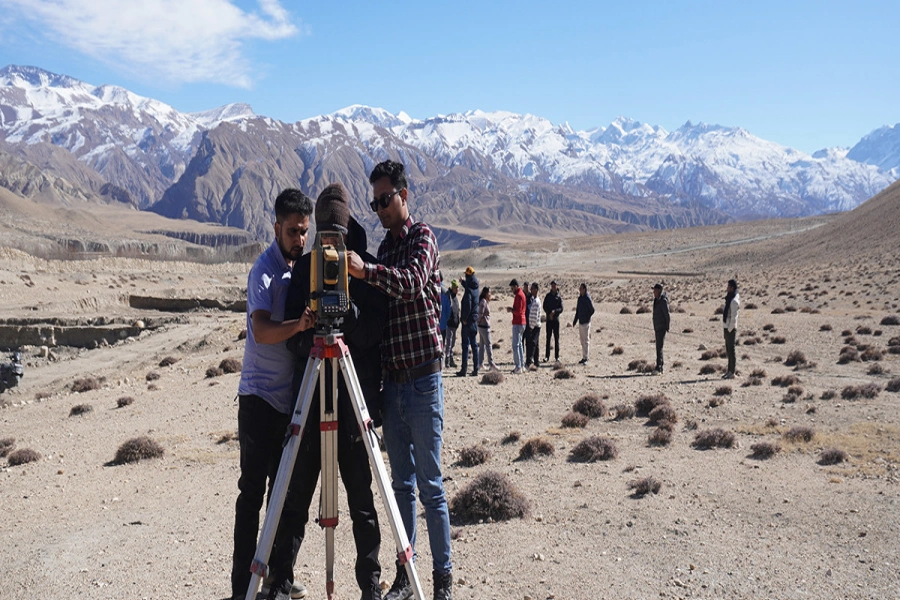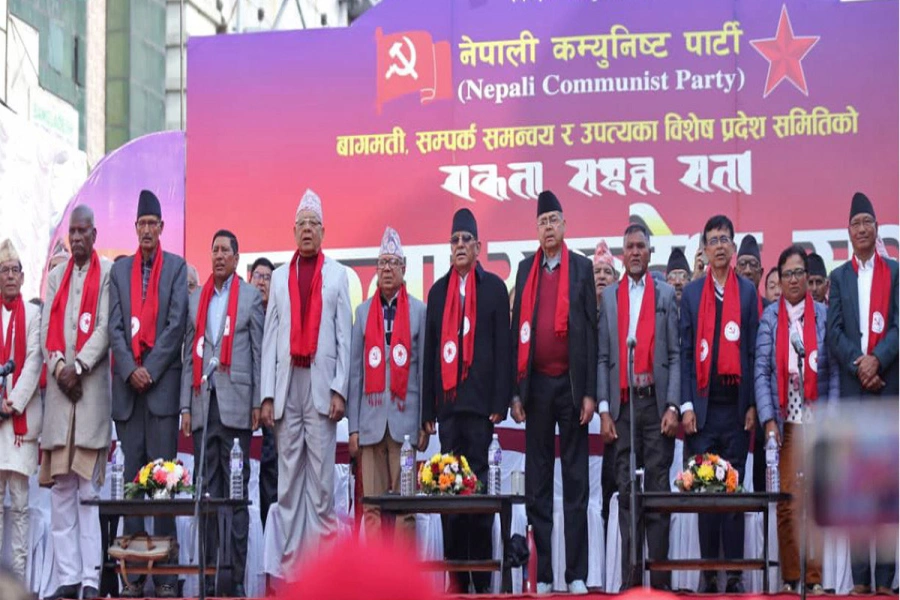Samantha Custer is the Director of Policy Analysis at Washington DC-based research institute AidData, which produces analysis of development investments and results and experiences of decision-makers in low- and middle-income countries regarding the impact of external money. During her recent visit to Nepal, she shared her insights on foreign aid, aid effectiveness and changing patterns of foreign assistance with Republica’s Mahabir Paudyal and Kosh Raj Koirala.
How do you see the nature of foreign aid?
Globally, historically for many decades, most of the financial interactions between the developed countries and developing countries have been in the form of aid. A very small club of actors was actively involved in providing aid. There were some bilateral actors like the US, Europe and Japan and multilateral actors like the World Bank and other international organizations. This very small set of international donors very similar to each other in terms of the rules of the game was dominant. There was not much of private sector investment. More recently, however, the landscape of financing for development has changed quite a bit. Traditional actors or donors have faced pressure from within their countries to reduce aid budget. There are some conversations happening in some of the advanced economies struggling with inequality. Tax payers are saying, ‘why are you investing overseas when you have poor people at home?’ At the same time, there is a greater diversity of funders which have started to give foreign assistance. So some middle-income countries, which used to be the recipients of aid, are giving assistance. India, China, Brazil are some examples. They have started to increase their own assistance. But the nature of such assistance is different from what we have seen in the past. Historically, donors have provided grants or no-interest loans. But now, some donors, who themselves have not fully advanced their economies, are providing more loans with market interest rate to support development.
Before either you had foreign direct investment that was fully private sector-led and it was only profit-driven and primarily in advanced economies or you would have an aid that was entirely concessional with no interest attached. Now there is public-private partnership, where you are carrying public sector money with private sector money. And there is the area called the blended finance where they are looking for the ways to decrease the risks for private sector actors to invest in countries. In short, the landscape of foreign aid has changed. The terms have become less generous over times but there are also more actors to choose from.
Aid effectiveness is another question of debate in recent times. There are people who say aid does not work at all. What does your study say?
Your question is related to the question of if the aid is going to the poorest countries because if the aid is about improving the lives of the people, it must go to the poorest countries. But it also depends on how you look at the world. If you look from the top down, aid actually goes to the poorest countries. But when you see below the national level, we find that actually the aid is not going to the poorest communities, rather it is going to the wealthier communities. There are two reasons for that. First, donors are often facing pressure from their own governments and their taxpayers to deliver the results quickly. What that means economically is aid sometimes goes to urban areas or well-connected communities so that it’s easier to deliver goods and services. The poorest communities are not very well-connected. This is why it is very difficult to deliver aid to them. The other reason is the lack of data sometimes. You only manage what you measure. If you have no way of ensuring that the aid is actually reaching the poorest communities and you are just hoping that it is, that also does not ensure aid-effectiveness.
I do not believe in the idea that aid does not work at all. Aid needs to work much better than it does. Aid often does not produce the results we want. This is because sometimes in some of these very remote areas, it is very difficult to deliver results. Sometimes the way that we design and finance the assistance is not very smart. Again some donors are better than others in terms of how willing they are to say ‘this is for funding, these are the terms and this is how we are doing.’ When donors are not transparent, it breeds corruption and corruption spoils the delivery. Governments should also demand more from donors and ensure that they are holding them accountable for results. Also we need better capacities within our agencies to effectively plan, to mitigate risks and monitor results. I found that this is a common refrain in Nepal. In place like Nepal, one of the best things you can do to attract private sector investment is to make it easier for investors to feel confident of investing in Nepal. Consistency of regulations, policy predictability and ensuring that profit can be repatriated are important. The other thing to ensure is how to decrease risks for private sector actors.
Nepal has been a major aid recipient country for over 70 years. But there has not been substantial change in the lives of people. Where does the problem lie?
Countries like Nepal need to find the balance between ensuring access to basic services and increasing productivity. There is an opportunity especially around infrastructure as Nepal is thinking about infrastructure a lot these days. Nepal needs to invest in things that actually create new jobs and opportunities for Nepalis. That’s the best way with which you can create sustainable growth.
I see that the debate in Nepal is going around transportation infrastructure. Studies show that if you increase spending in the transportation sector and you pair up with improvements in governance, institutions and capacity that’s going to bring six times the growth benefits than if you just increase spending. Government offices in Nepal also acknowledge that they feel the need for more capacity. Some of that comes from investing in local governments and national governments. Investing in civil society and media to push the government to have the incentives to improve their capacities is also important.
The countries have more choices now than ever before in terms of where they can get financing for development. That means that countries like Nepal need to think about what type of financing is appropriate for which projects. The first thing to think about is if I access financing for infrastructure projects today, what is it going to cost me to repay this tomorrow. If it’s grant, or no-interest loan or traditional aid, that amount today or tomorrow is the same. There is nothing to repay. But if it is market-based loans or private sector investments, you need to think when I have to repay it’s going to be principal plus interests.
Sometimes there is a political cost to receiving aid, grants or loans. Increasingly with bilateral actors and some of the emerging donors, it is coming up more often where if I lend you money today a couple of months down I may come back and say I lent you money then now I want you to support me in foreign policy position or at the UN. There is a kind of quid pro quo back and forth.
Making a great first impression at an interview

Often people discuss what is good level of debt to GDP? There is no rule of thumb consistently but often they say for developing country you should stay at no more than 40 percent of debt to GDP. Nepal has actually done quite well. So far, it’s about 32 percent debt to GDP. But this is something to watch because if you start taking market-based loans, that changes rather quickly.
I see that a lot of discussion is going on about railway investment in Nepal. The question you need to ask is if you build the railway from the market-based loan, what’s the benefit for Nepal? Who will use it? How will it be used? If it was a grant-based assistance, you would not have to think about having to repay the loan. But if you are borrowing to build this you need to consider how it will generate revenue to repay the loan. One of the reasons why the funder is excited to build it is because they want to connect it with Indian market and it is beneficial to the funder. Nepal should think about how it will benefit Nepal. If Nepal has a credible strategy to use the railway investment to boost its export that it is going to generate revenues upside the cost, Nepal should go for it by all means. But if Nepal has no credible plan and you are basically taking on debt with no clear guarantee that you will be able to repay it and that there will be local trickle down benefits to the economy, railway is going to be a costly proposition. Thus there is nothing like commercial loans are bad and you should always take in grants-based assistance. All that you need to care about it is that financing is fit for purpose with what you are investing in.
How do you see the trend of Chinese investment around the world? Some argue, citing Sri Lanka’s example, that Chinese loan puts borrowing country in debt.
I think there has been a lot of politicization of Sri Lanka’s case. I would say two things. One, Sri Lankan government has the responsibility to borrow wisely and invest wisely. Unfortunately, Sri Lanka was carried away by borrowing way too much from across many different external investors and actors. The burden was way too much. I would say debt of Sri Lanka is not necessarily because of China alone. Chinese investment may have only exacerbated the level of debt. Countries have to decide how much they can borrow. I was in the Maldives earlier this year. They actually had borrowed so much externally. Their debt to GDP ratio may be 6o to 70. Essentially they borrowed so much that traditional actors like World Bank and International Monetary Fund said ‘you are done, you cannot borrow anymore concessional aid.’ I think the challenge with some of the emerging donors is that they may not say that. Donors do not seem to think through how to help country manage their debt sustainably and countries themselves do not seem to have capacity and flexibility to know how much is too much.
But what are the actual trends of Chinese investments around the world?
China has seen a major uptake in investment globally. They have been investing in development since the 1950s. But there has been a huge spike in assistance after 2008, around the time of financial crisis when traditional donors started turning inward to look at their own debt issue. But we have seen increasing uptake in investment of China after 2015 under Belt and Road Initiative (BRI). China has become increasingly interested in investing. There are multiple drivers for that. One is economics. China has accumulated over three trillion dollars excess foreign currency reserves. Its current capacity to put that to productive use is not very strong and their economy is slowing down. So it is adopting ‘going global’ strategy.
Leader like Xi Jinping is interested in gaining international respect and stature for China on a global stage. So there is big interest in investment in big project like BRI where Asian Infrastructure Investment Bank (AIIB) will help to finance it. We did a study comparing the US and Chinese investment. In 2014, if you look at concessional loan and grant alone, the US is four times the size of China in terms of traditional aid. But if I add here other financial assistance flow that includes not only grant and concessional loans, the difference between US and China’s overall financial assistance globally is actually much less. To date, globally China has given about 354 billion dollars. In Southern and Central Asian region, China has given is 120 billion dollars. Of that less than one billion dollar has gone to Nepal. Chinese aid has actually surpassed many of the traditional donors in terms of volume and their investment tends to be less concessional. Also, they have uniquely heavily focused on infrastructures. For example, 92 percent of Chinese investments in Nepal are in infrastructure development. Even in other countries in the region, that percent is above 90 percent.
Why do you think is China focusing its investment heavily on infrastructures?
There are two reasons. One, because of the economic returns. So, they are investing in increasing connectivity for trade of Chinese goods overseas. Building regional infrastructures helps China export more. It has excess monetary capacity and excess construction capacity domestically. So many Chinese investments overseas are tied to the use of Chinese firms and labors.
What are the differences between Chinese and World Bank Group’s financing on infrastructure development?
There are a couple of differences. One is scale. World Bank and Asian Development Bank give small amount of loan, but China gives much more. Other difference is related to their social and environmental safeguards. WB and ADB ensure that there is minimum risk to local people while building infrastructures. They have certain checks in designing such projects, but China has not given much consideration to these aspects. Thus, there are certain problematic and certain beneficial aspects. Actually, when it comes to tying the financing to the articulative priority of countries themselves China does quite well in infrastructure in Asia Pacific, specifically because so many countries say infrastructure is a priority. But I do not know if it is the local priority. When you assess the impact of infrastructure projects like building connectivity of roads and power plants, these generally tend to be associated with increased economic growth. They actually reduce inequality. On the flipside, there are different rules that govern Chinese construction projects. For countries that are interested in infrastructures there is a ready source of financing from China. But I think there are a lot of financial, social and environmental risks.
It is said even World Bank is responsible for creating debt burden. What does your study show?
Anytime countries are borrowing, they are assuming that there are risks. It does not matter who the funder is, World Bank, China or the US. I am not aware of specific examples of World Bank. But I know that certain World Bank projects have been more effective than others. I know that poor countries that are not part of highly concessional lending programs or the countries that are borrowing with some interest rates have the risk of debt. It is more pronounced when the interest rates are higher or when the countries are borrowing too much.
What could be the middle path for Nepal given that it is desperately looking for bringing more investment in mega infrastructure projects?
Whatever projects Nepal is implementing should be open and competitive. Projects get delayed or mired in corruptions usually due to lack of transparency. Countries that have made commitment to open and competitive projects see cost go down and benefits of the projects going to the people. Second thing to consider is to make sure that you are matching the financing with the type of project with the types of infrastructures. There are projects which do not generate revenues immediately but important for societies. These are projects not suited for high-interest rate loan. For productive infrastructures like power plants you have more options to think about.
Finding ways to diversify financing is critical for Nepal. I found that there is an interest to crowd in private sector investment in Nepal. There are four things that make private sectors shy away from making investment in a country. They include high transaction cost, inability to mitigate risk and lack of transparency and inconsistency in regulatory department. Finding ways to crowd in investment from other donors in infrastructures is also going to help Nepal have a greater leverage. There are couples of ways to do this. One is tackling the under-spending of budget. This creates concerns among donors that money is not being managed effectively. It is also important to tie infrastructure with social priority.
World Bank and Asian Development Bank do not have enough budgets for infrastructures but they have excellent technical assistance and really good standards for how to ensure social and environmental economic of infrastructures. Learning as much as possible from them is good for Nepal. The great thing about MCC compact is technology transfer where you have opportunity to reduce maintenance cost overtime and use technology even beyond the five years of compact. The size of the project is not as large as other investment you may be thinking about, but there is technology transfer benefit that is going to help you. Again, if you find an opportunity to negotiate good terms with China why would you not accept the funding? It is just a matter of increasing your leverage to say we want better terms for loans.






































